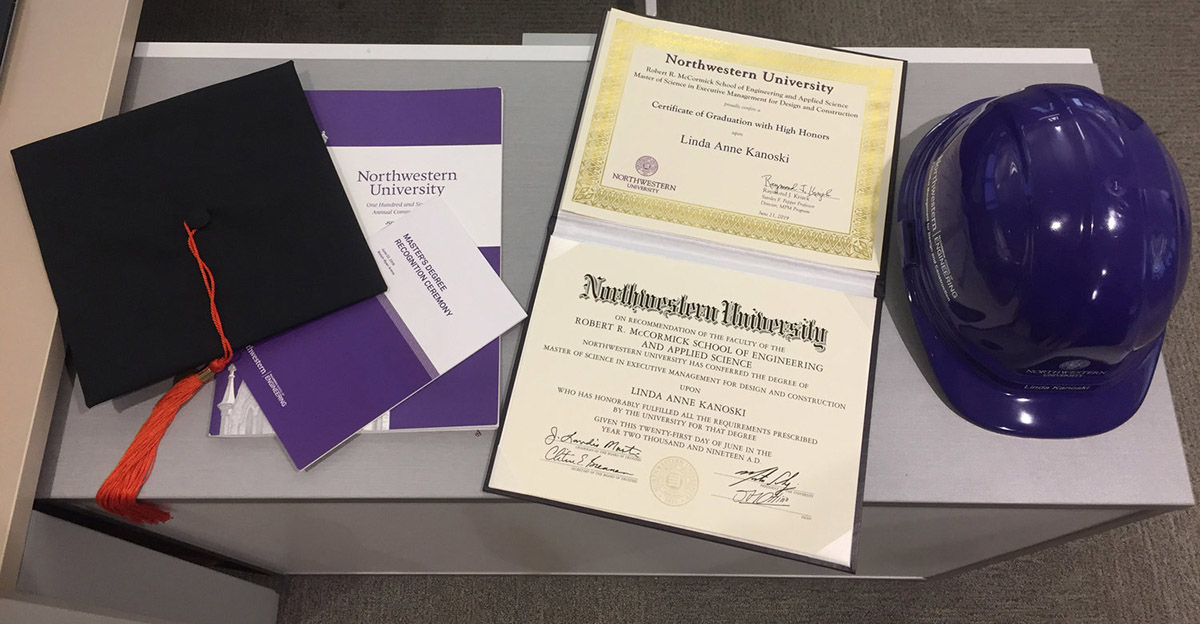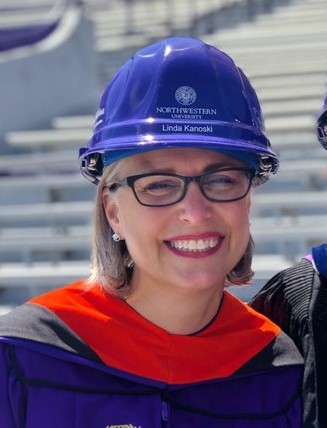Going Above and Beyond with Continuing Education
Linda Kanoski, AIA, Senior Project Manager at CBRE, has recently gone above and beyond the typical standards for higher education by earning a Master of Science from Northwestern University’s Executive Management for Design and Construction (EMDC) program.

The architectural profession requires that its practitioners engage in constant education. The American Institute of Architects (AIA) has a formalized program for continuing education, as does the International Interior Design Association (IIDA), American Society of Interior Designers (ASID), and many other professional associations. Given the changing nature of the practice, it is understood that dedicated architects and designers will not only comply with these requirements but actively seek them out and enjoy them.
 Linda Kanoski, AIA, Senior Project Manager at CBRE, and 30-year veteran of the architectural profession, has recently gone above and beyond the typical standards for higher education by earning a Master of Science from Northwestern University’s Executive Management for Design and Construction (EMDC) program (and with high honors, no less).
Linda Kanoski, AIA, Senior Project Manager at CBRE, and 30-year veteran of the architectural profession, has recently gone above and beyond the typical standards for higher education by earning a Master of Science from Northwestern University’s Executive Management for Design and Construction (EMDC) program (and with high honors, no less).
“I call it an MBA for architects,” Linda says. Having considered a traditional MBA during the course of her career, Linda had always planned on achieving a master’s degree not only to improve her value to her clients, but to feed her hunger for learning. It wasn’t until she discovered the EMDC program that she committed. “I could either get a very broad business education through a traditional MBA, or I could enroll in this business program, which is specifically geared toward what I do.”
The program, offered by the McCormick School of Engineering, is aimed at executives in the AEC industry and requires a minimum of 8+ years of experience. This results in a student body that has real-world experience that they can bring to classroom discussions. Linda describes it as a reciprocal relationship. “I learned nearly as much from my classmates as my teachers. It was a pleasure to get to know them and learn from their stories.” The program’s esteemed faculty draws from a roster of design and construction industry professionals, as well as specialty fields such as communications and business development.
The core curriculum focuses on an assortment of soft and hard skills necessary for success within the AEC industry, which include accounting, finance, leadership, business strategy, construction law, and human resources. Throughout her experience, Linda was pleasantly surprised by the level of engagement these courses offered. “Leadership and organization was taught by two retired Navy Captains, engineers by training, who brought a nuanced view of hierarchy to our less structured environment.” She also describes the course on human resources as a pleasant surprise, as it focused specifically on organizational development directed at engaging, nurturing, and retaining employees.
Beyond the required courses, Linda took advantage of several thought-provoking electives. One particular course that had a profound influence on her worldview was Systems Thinking for Sustainable Design. “This class framed each person as part of multiple interweaving systems, each having an effect on all others.” On a business level, this meant diving deep into her clients’ true essence and understanding how they fit into the wider systems in which they are nested, including how they impact their clients’ businesses as well as the communities in which they operate. “So we’re tasked with understanding our clients on a truly profound level in order to create a space in which they can do their best work.”
As the program is run by Northwestern, students are also allowed the privilege of choosing electives offered by the world-renowned Kellogg Graduate School of Management. Given that a handful of professors were seasoned veterans from the construction industry, the program provided a close communion between designers and contractors, offering insight into what can sometimes be a contentious relationship. “The program taught me a side of the contracting profession that I didn’t previously fully understand, which gave me a deeper appreciation for what construction professionals bring to the table.” Linda notes that she has since refined her approach to the collaborative process with contractors thanks to the perspective gleaned in the EMDC program.
In addition to enriching the design process, the EMDC program provides courses for fostering better teamwork. “The Lean Construction class dealt with philosophical principles, but the classwork focused on creating a fluid and thriving team environment, which I can bring to my teams.”
Architecture and interior design are known to exist where art and science meet, requiring its professionals to think in both the lofty terms of creativity and the grounded world of feasibility. The EMDC program elevates this approach by providing thought-provoking and compelling classes that uphold Northwestern University’s top tier educational reputation. “I loved every minute of it,” Linda concludes. “Earning my Master’s in the EMDC program has already had a tangible impact on my career trajectory, and I expect the business principles I learned in the program to continue to fuel my career well into the future.”

